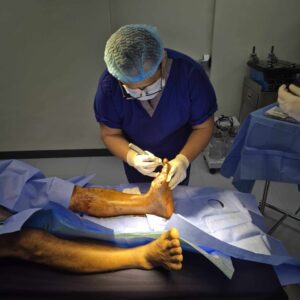Understanding the Role of a Doctor for Wound Dressing
When it comes to wound care, having a doctor for wound dressing plays a critical role in ensuring proper healing and avoiding complications. Wound dressing is much more than just covering a wound with a bandage. It involves thorough assessment, cleaning, selecting the right materials, and ongoing monitoring to promote recovery. Doctors trained in wound care evaluate wounds carefully to understand their severity, depth, and risk factors like infection or underlying health conditions. Different wounds, whether from surgery, accidents, or chronic illnesses, demand specific approaches that a doctor can expertly provide. Professional care also helps identify when wounds may require more advanced treatments or referrals to specialists. By entrusting wound management to a qualified doctor, patients receive personalized attention that supports tissue repair and prevents problems before they arise. This expertise is especially important for wounds that fail to heal normally or those with a high risk of infection.
Different Types of Wounds and Appropriate Dressing Techniques
Wounds can be categorized broadly as acute or chronic, and each requires a distinct approach to dressing. Acute wounds, such as cuts, surgical incisions, or burns, typically heal within a predictable timeframe with proper care. Chronic wounds, including diabetic ulcers or pressure sores, often need ongoing management because they persist longer and can worsen without treatment. Doctors for wound dressing assess the wound’s characteristics to determine the most effective dressing technique. Surgical wounds might require sterile gauze or hydrocolloid dressings, while burns often benefit from specialized foams or gels that keep the area moist and protected. Traumatic injuries may demand multilayer dressings to control bleeding and shield exposed tissues. For wounds that involve infection or excess fluid, doctors may use alginate or antimicrobial dressings. Understanding the wound’s nature helps doctors select materials that support healing stages such as inflammation, tissue growth, and remodeling.
How a Doctor Determines the Best Dressing Material
Choosing the right dressing material is a crucial decision that significantly influences healing outcomes. Doctors consider several factors when selecting wound dressings, including the size and depth of the wound, the presence of infection, the amount of exudate (fluid), and the patient’s overall health. Gauze remains a common material for light to moderate wounds but might not be suitable for wounds needing a moist environment. Hydrocolloid dressings create a moist healing space and are often used for ulcers or burns. Foam dressings are highly absorbent and protect fragile skin, while alginate dressings help control bleeding and heavy drainage. Infection control is a top priority, so doctors may apply dressings containing antimicrobial agents or coordinate antibiotic treatments alongside dressing changes. The doctor’s expertise in matching wound needs with appropriate materials helps accelerate healing and prevents complications like skin maceration or bacterial growth.
The Doctor’s Approach to Wound Care Management
The process of wound care management led by a doctor extends beyond just dressing the wound. Initial steps often involve careful cleaning and debridement—removal of dead tissue—to prepare the wound bed for healing. Doctors monitor key signs of healing such as reduction in redness, swelling, and drainage, along with patient comfort. The frequency of dressing changes depends on the wound type and its condition; some wounds need daily care, while others may allow less frequent changes. Proper pain management is integral to wound dressing sessions, as discomfort can affect healing and patient compliance. Doctors also educate patients or caregivers on how to care for wounds between visits, emphasizing hygiene and protection from further injury. This comprehensive management helps maintain an optimal environment for tissue repair while reducing risks of infection and complications.
When to Seek a Doctor for Wound Dressing
Knowing when to consult a doctor for wound dressing is essential for preventing wound deterioration. Some wounds may seem minor but can quickly worsen without proper care. Warning signs that require medical attention include increased redness, swelling, foul odor, pus discharge, or persistent pain. Chronic wounds that do not improve over weeks should always be evaluated by a healthcare professional. Self-treatment or using inappropriate dressings can lead to infections or delayed healing, making professional intervention crucial. Timely care by a doctor reduces the chance of serious complications such as sepsis or tissue necrosis. For patients with diabetes, immune disorders, or vascular diseases, professional wound care is even more critical due to their higher risk of impaired healing. Doctors also coordinate care with specialists like infectious disease experts or surgeons when complex wounds demand additional therapies.
Benefits of Professional Wound Dressing by a Doctor
Receiving wound dressing from a doctor offers numerous benefits that cannot be matched by home care alone. The most immediate advantage is a lower risk of infection, as doctors use sterile techniques and choose dressings specifically suited to the wound’s needs. Professional care supports faster healing by maintaining an optimal moisture balance and protecting fragile new tissue. Skilled dressing helps prevent excessive scarring and tissue damage, which can improve both function and appearance. Doctors tailor wound care plans to individual patients, considering factors such as age, nutrition, and underlying health conditions. This personalized approach is vital for managing wounds that are slow to heal or complicated by infection. Regular follow-ups allow doctors to detect any changes early and adjust treatments accordingly. Overall, the involvement of a trained doctor ensures safer, more effective, and less painful wound recovery.
Frequently Asked Questions (FAQs)
How often should wound dressings be changed by a doctor?
The frequency depends on the wound type and condition. Some wounds need daily dressing changes, while others may require changes every few days. Your doctor will guide you based on the healing progress.
Can all wounds be dressed at home or should some always see a doctor?
Minor wounds might be managed at home, but wounds that are deep, infected, or slow to heal require a doctor’s evaluation. Complex or chronic wounds should always be professionally managed.
What are the signs of infection a doctor looks for in wound care?
Doctors watch for increased redness, swelling, warmth, foul odor, pus, fever, and worsening pain, which can indicate infection requiring treatment.
Are there special considerations for diabetic patients in wound dressing?
Yes, diabetic patients have a higher risk of poor wound healing and infection. Doctors closely monitor these wounds and may use specialized dressings and treatments to promote healing.
How does a doctor handle pain during wound dressing?
Pain management may include topical anesthetics, gentle cleaning techniques, and sometimes oral pain medications to ensure comfort during dressing changes.











